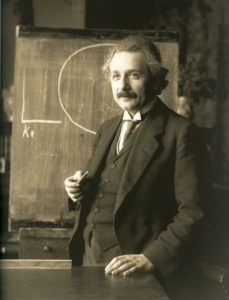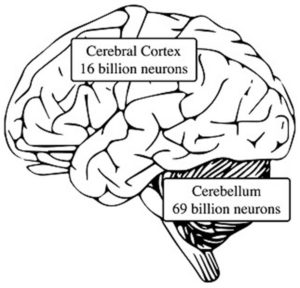 The May, 2017 issue of National Geographic began a series on the topic of Genius. The issue contained many interesting brain findings related to genius, including that of Albert Einstein. However, it left out an important new direction in neuroscience studies on the topic.
The May, 2017 issue of National Geographic began a series on the topic of Genius. The issue contained many interesting brain findings related to genius, including that of Albert Einstein. However, it left out an important new direction in neuroscience studies on the topic.
To better understand the processes behind the wholly new thought of a genius like Einstein, there is now considerable brain imagining evidence that provides a dramatic change in the way we think about how the brain produces advances in both thought and creativity.
This major change in thinking is based on countless imaging studies that reveal how the 69 billion neurons of the brain’s cerebellum contribute not only to the constant refinement of thought but to creativity.
The new view of how the brain produces genius

It is now recognized by a growing number of neuroscientists that, in conjunction with the cerebral cortex, the smaller cerebellum is necessary to the computation of higher levels of thought.
The cerebellum provides this absolutely critical contribution by constantly improving the speed, appropriateness, and efficiency of all movement, thought and creative processes. The cerebellum makes these improvements with each attempt a person makes to solve any and all problems.
To help understand the powerful relationship between the cerebellum and the cerebral cortex it is first important to note that the human cerebellum has increased three- to four-fold in size in just the last million years. Further, this rather rapid and dramatic increase in the size of the cerebellum has included:
- The emergence of large cognitive areas in the cerebellum that are dedicated to the constant improvement of language-driven thought, and
- The extension of a massive number of two-way nerve tracks (20 million on each side of the brain) between the cerebellum and the frontal and parietal high-level thought and planning areas of the cerebral cortex. This latter development means that anything that is repetitively thought about is constantly improved via more efficient, streamlined modeling by the 69 billion success-predictive neuron circuits in the cerebellum.
It is important to note here that the contributions of the cerebellum occur below the level of conscious awareness. These increased efficiencies of thought are then sent back to the cerebral cortex to unconsciously influence advanced thought (often popping up in the form of what we experience as intuition) and/or implementation in advanced problem solving.
How the cerebro-cerebellar system produces advances in thought
Beginning in infancy, experiences that are developing toward “thought” take place in what is becoming working memory in the cerebral cortex. Working memory refers to the stream of pictures and language that constitutes ongoing thought. Simultaneously, as this experience of early thought is repeated, the cerebellum encodes ordered sequences of the structure of this developing thought. And, in order to use these sequences to predict what is coming next the cerebellum may blend sequences to make better predictions.
The evolutionary adaptive advantage of this cerebellar encoding is that it progressively selects thought patterns that are faster, more consistent, and more appropriate to the problem at hand. As these patterns are learned in the cerebellum, they may be blended and become more unconscious and automatic, often suddenly entering consciousness in the cerebral cortex as intuition.
In my 2015 article that appeared in the journal Cerebellum & Ataxias, I described how this process might have worked in the case of Albert Einstein. In Einstein’s case, he told us that at age sixteen he imagined the following paradoxical problem:
“If I pursue a beam of light with the velocity c (velocity of light in a vacuum), I should observe such a beam of light as a spatially oscillatory electromagnetic field at rest. However, there seems to be no such thing [possible],”
What Einstein imagined here was what a beam of light should look like when it’s not moving at 186 thousand miles a second.
Einstein’s cerebral cortex (in conjunction with what his cerebellum has also learned over the years) had imagined a possible blending of the speed of light itself with everyday experience. Then, in the ensuing years of Einstein’s pondering of this question, his cerebellum worked to make this idea of a new blend of observations and ideas more appropriate and more predictive toward solving the problem of what a beam of light at rest would actually look like.
Einstein said he solved this problem through intuition and came up with his special theory of relativity. To see how his intuition solved it, please see the explanation near the end of my 2015 article.
Why do some people become geniuses?
The foregoing explanation of the early emergence of thought in the infant leads directly to an explanation of why some people become geniuses. Some individuals naturally have accelerated cerebellar functions toward improvement of cognitive processes. Due to learning conditions, mentor support and hard work (and a degree of luck) some of these individuals become well-known geniuses (like Einstein).
Another class of such individuals due to intrinsic motivation, their unique learning conditions and so forth, may become child prodigies. Further, as Vandervert (2007) argued, through highly motivated deliberate practice still other individuals may significantly accelerate the production of their cerebellar functions through long, dedicated hard work, and mentor support.
Placing the newer research within the context of National Geographic’s article on genius
I have placed these newer understanding directly within the context of examples from Claudia Kalb’s May, 2017 article on “Genius” that appeared in National Geographic. Please send me an email at LVandervert@aol.com for the details.
Also, see why science is actually an extension of play at: “Vygotsky Meets Neuroscience: The Cerebellum and the Rise of Culture through Play<https://www.journalofplay.org/issues/9/2/article/3-vygotsky-meets-neuroscience-cerebellum-and-rise-culture-through-play>” as published in Volume 9, Issue 2, of The Strong’s American Journal of Play.
Larry Vandervert
Professor Vandervert argues that the cerebellum refines the brain’s knowledge of all cause-and-effect relationships related to movement, thought, social behavior and emotion.He proposes that sequence detection in the cerebellum more than any other brain process led early humans to stone-tool manufacture, then to advances in technology, and to science.In other words, it is the cerebellum that provides the breakthroughs (often experienced ad insight and intuition) necessary to the creativity behind the rise of Homo sapiens as well as the continual advances of the technological, scientific, mathematical, artistic and political aspects of their cultures throughout history.
For the latest in-depth social-cognitive cerebellum research and to learn more about Dr Vandervert’s work, visit his page here and find out more about the newly published book The New Revolution in Psychology and the Neurosciences.
It is one of the conclusions of special relativity that a beam of light cannot be at rest in any inertial frame, so your notion that Einstein’s cerebellum, or any other part of his brain, figured out how to “solve this problem” of what it would look like is too vague to make any sense, if it isn’t just wrong.
Actually, pardon me, it is the basic assumption of SR that differs from pre-relativity mechanics that light always goes at the speed of light, Einstein’s cerebellum would have had to reconcile this seemingly contradictory notion with his intuition which, initially, was wrong, like everyone else’s. If you want to understand genius I think you should leave such complex problems as the creation of physical theories, which are far removed from the workings of a single brain, and understand things like how to get toothpaste back in a tube, for example, which if anyone can figure out I would like to know.